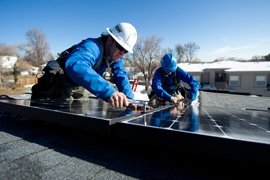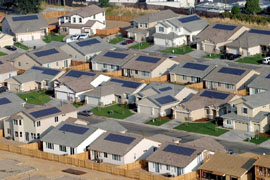Cronkite News has moved to a new home at cronkitenews.azpbs.org. Use this site to search archives from 2011 to May 2015. You can search the new site for current stories.
Solar energy still in firewood’s shadow for heating homes in Arizona
WASHINGTON – Gary Jordan has been selling firewood for three decades and his family has been heating with it for three generations. But a few years back he got curious and looked into solar energy.
“I would love to have solar panels there at my house,” said Jordan, the owner of Paul Bunyan’s Firewood in Tempe. “But that initial cost, you know, it’s a shocker.”
Jordan’s decision to stick with firewood made his home one of the 48,836 in Arizona that use firewood for heating – 30 times the number of Arizona homes that use solar energy to keep warm.
Only 1,620 Arizona homes rely on solar energy installations to provide heating, according to statistics from the U.S. Census Bureau, ranking sun-soaked Arizona seventh in the nation for homes with solar heating.
That’s surprising to Joseph DiMatteo, owner of Sunpower of Arizona in Tucson.
“I would challenge it to be honest,” said DiMatteo. “I don’t know of anybody that heats their home with wood. Everybody has a fireplace, but it’s not for heating – it’s for show.”
Arizona’s adoption of solar is better than the nation’s as a whole, where the number of wood-heated homes is 57 times greater than the number of homes heated with solar. But the state still trails Colorado, New Mexico and Hawaii in the number of homes using solar for heating, even though those states have fewer total homes than Arizona.
The solar vs. wood numbers come from the Census Bureau’s 2010 American Community Survey, which surveyed about 3 million homes over the year. The survey has 21 questions pertaining to people’s homes.
“Wood and solar are part of the same question, and the question is which fuel is used most to heat the home?” said Chris Mazur, survey statistician for the bureau’s Housing Statistics Branch. “People would have to consider that ‘most’ however they interpret it . . . because we only take one answer.”
DiMatteo, whose company has been around since the 1980s, said the cost of home solar installations – currently anywhere from $20,000 to $100,000 – could explain solar energy’s low adoption rate in Arizona. Still, he said he expected more Arizonans to be using solar for heating.
“Certainly Arizona has been one of the primary adopters of solar energy throughout the U.S., but probably not to the extent that our solar resources would suggest we should,” he said.
“Part of that is cost, part of that is political . . . part of that is public perception, so there’s various reasons why,” DiMatteo said.
Experts believe sunny Arizona has the potential to generate enough solar energy to power the entire country. And last year, Arizona added the third-most solar energy developments, behind only California and New Jersey, according to a report released this month by the Solar Energy Industries Association.
But if Arizona is ever to take the lead in solar installations in the U.S., Arizonans have to get behind it, said Harvey Bryan, a senior sustainability scientist at Arizona State University’s Global Institute of Sustainability.
“California is 35 million people, and a lot of them want to have solar in their homes,” said Bryan. “Arizona was later to the table … and has not been as aggressive as California.”
But as solar installation prices continue to fall, DiMatteo expects the numbers will begin to change.
“As the price of solar electricity comes down, the adoption rate will start to come up,” he said. “It’s certainly becoming much, much more prevalent.”
Jordan agrees that it is going to take a price drop to convince people to start thinking about solar when they think about keeping warm. In the meantime, he’s not worried about his sales, which he said have consistently gone up.
“People get the enjoyment out of sitting there,” Jordan said. “You get the continuous warmth from a fireplace.
“Firewood has been around since the Stone Age,” he said.








